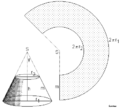Developable area
A developable surface designates from the point of view in geometry or in differential geometry , cartography and topology a two-dimensional surface that can be transformed into the Euclidean plane without internal shape distortion . A finite number of cuts can be made, but the individual parts must then be able to be laid flat on one level without further upsetting or squeezing.
The best-known examples are the surfaces of certain three-dimensional bodies such as cubes or cones . The mathematical definition runs more generally through the inner metric and curvature and is independent of a possible embedding . However, for the special case of descriptive, three-dimensional, Euclidean space with induced metrics, every developable surface is also a ruled surface , although ruled surfaces are defined quite differently. The reverse does not apply and the statement for surface embedding in higher-dimensional Euclidean spaces does not apply either .
A developable ruled surface is also called a torse .
definition
A surface, or more precisely a two-dimensional differentiable manifold , is called developable if its Gaussian curvature is zero at every point on the surface , which happens exactly when one of the two (or both) main curvatures is zero.
A Riemannian manifold of dimension , whose Riemannian curvature tensor is zero everywhere, is called a flat manifold . So one can understand a developable surface as a two-dimensional flat manifold.
Examples
Developable bodies
The Oloid is one of the very few known bodies, the entire surface of which is kink-free and can be developed in one piece. Even angular bodies such as prisms , pyramids or polyhedra have developable surfaces, the edges do not influence this: A geodetic line can run over the edge of a prism without a "kink" and has a straight course after spreading into the plane.
Lateral surfaces

Here: Obermillstatt in Carinthia with an onion diameter of 8.5 m
Important developable outer surfaces are u. a. the surfaces of cylinders and cones . The structures, points, coordinate lines etc. on it do not change their mutual position when the surface is "spread out" in the plane. This property is important for cartography and geodesy , for example for cone projections or the pseudo-cylindrical Gauss-Krüger mapping.
The feature of true-to- shape development applies regardless of the cross-section of the original surface, e.g. B. also for elliptical cylinders.
Approximate solid of revolution
While simple bodies of revolution such as cylinders or cones can be exactly developed as a lateral surface, this is no longer possible with more complicated bodies of revolution. In practice, this helps to assemble the body from individual, developable segments which - unlike the lateral surfaces - are not developed around the axis of rotation but along the axis of rotation. The larger the number of segments selected, the closer the composite body approximates the ideal solid of revolution.
Onion domes are a fine example of such approximated bodies of revolution . In principle, any approximated rotational bodies - including spheres or ellipsoids - can be developed segment by segment with this method .
Non-developable areas
Non-developable surfaces are those that are curved in two dimensions, such as the sphere , the earth's ellipsoid, or various saddle surfaces . Here, with every mapping on a plane ( map , optical mapping, etc.), there are small or larger changes in shape, the so-called distortions .
Technical drawing
In technical drawing one speaks synonymous with the developable surface of the development (a surface). The development is the graphic representation of the developed area, which is required, for example, in the manufacture of sheet metal pipes (e.g. plumber required) to cut the sheet metal ( sheet metal development ).
Even if angular or angular bodies are rarely used for developments in practice, one or the other prism or one or the other pyramid is also shown developed in the training of the technical drawing in order to convey the basics of the construction of such developments.
- Settlement
Development of a cylinder
Unwound truncated cone
additional
- Length fidelity ; that is, each arc merges into an equally long one. In particular, geodetic lines merge into straight lines or straight lines.
- The developable surfaces (except for the plane) are envelopes of single-parameter sets of planes.




